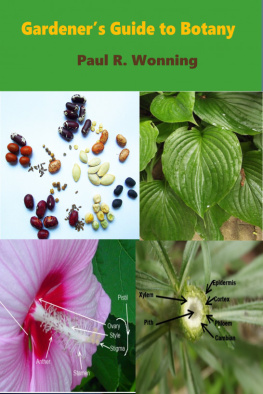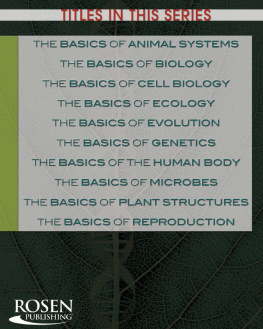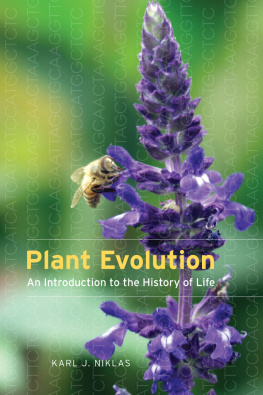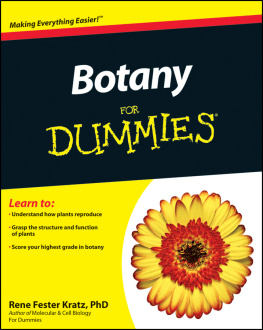James D. Mauseth, PhD
University of Texas at Austin
SIXTH EDITION
Botany
An Introduction to Plant Biology

World Headquarters
Jones & Bartlett Learning
5 Wall Street
Burlington, MA 01803
978-443-5000
www.jblearning.com
Jones & Bartlett Learning books and products are available through most bookstores and online booksellers. To contact Jones & Bartlett Learning directly, call 800-832-0034, fax 978-443-8000, or visit our website, www.jblearning.com.
Substantial discounts on bulk quantities of Jones & Bartlett Learning publications are available to corporations, professional associations, and other qualified organizations. For details and specific discount information, contact the special sales department at Jones & Bartlett Learning via the above contact information or send an email to .
Copyright 2017 by Jones & Bartlett Learning, LLC, an Ascend Learning Company
All rights reserved. No part of the material protected by this copyright may be reproduced or utilized in any form, electronic or mechanical, including photocopying, recording, or by any information storage and retrieval system, without written permission from the copyright owner.
The content, statements, views, and opinions herein are the sole expression of the respective authors and not that of Jones & Bartlett Learning, LLC. Reference herein to any specific commercial product, process, or service by trade name, trademark, manufacturer, or otherwise does not constitute or imply its endorsement or recommendation by Jones & Bartlett Learning, LLC and such reference shall not be used for advertising or product endorsement purposes. All trademarks displayed are the trademarks of the parties noted herein. Botany: An Introduction to Plant Biology, Sixth Edition is an independent publication and has not been authorized, sponsored, or otherwise approved by the owners of the trademarks or service marks referenced in this product.
There may be images in this book that feature models; these models do not necessarily endorse, represent, or participate in the activities represented in the images. Any screenshots in this product are for educational and instructive purposes only. Any individuals and scenarios featured in the case studies throughout this product may be real or fictitious, but are used for instructional purposes only.
09604-0
Production Credits
VP, Executive Publisher: David D. Cella
Executive Editor: Matthew Kane
Associate Editor: Audrey Schwinn
Associate Production Editor: Alex Schab
Marketing Manager: Lindsay White
Manufacturing and Inventory Control Supervisor: Amy Bacus
Composition: Cenveo Publisher Services
Cover Design: Kristin E. Parker
Rights & Media Specialist: Jamey OQuinn
Media Development Editor: Shannon Sheehan
Media Development Editor: Troy Liston
Cover Image: Tongho58/Moment/Getty
Front Matter Image: Courtesy of Will Klemm
Printing and Binding: RR Donnelley
Cover Printing: RR Donnelley
Library of Congress Cataloging-in-Publication Data
Names: Mauseth, James D., author.
Title: Botany : an introduction to plant biology / James D. Mauseth.
Description: Sixth edition. | Burlington, Massachusetts : Jones & Bartlett
Learning, [2016]
Identifiers: LCCN 2016005564 | ISBN 9781284077537
Subjects: LCSH: BotanyTextbooks.
Classification: LCC QK47 .M38 2016 | DDC 580dc23
LC record available at http://lccn.loc.gov/2016005564
6048
Printed in the United States of America
20 19 18 17 16 10 9 8 7 6 5 4 3 2 1
BRIEF TABLE OF CONTENTS
TABLE OF CONTENTS
PREFACE
The preparation of this Sixth Edition of Botany had two objectives: first, to emphasize the interactions between plants and other organisms, and second, to make plant biology more accessible and relevant to students and other readers.
The emphasis on plant interactions with the biosphere began several editions ago, as the reality of global climate change became clear. Previous editions explored the role of plants in the removal of greenhouse gases and also the loss of many forests by human activities. While thinking about the interrelationships of plants and people, I suspected that students would be interested in the ways in which plants interact with all other organisms. I believe it is more realistic and engaging to examine plant biology as one aspect of the set of all the interactions of organisms and Earth. To take a reductionist view of plant biology as just the anatomy, metabolism, and evolution of isolated plants is to miss out on many of the richest aspects of plant biology.
Consequently, in this Sixth Edition, a new : Development and Morphogenesis.
Making plant biology more accessible to students and everyone else was the reason I originally began writing this book 30 years ago. It has also been a primary concern in every new edition. Some reviewers and professors have felt that previous editions of Botany were too difficult for their students, and, to address their concerns, I have added a new : Overview of Plant Life. This is structured to provide a broad introduction to topics such as plant structure, metabolism, genetics, diversity, evolution, and ecology. An entire chapter was dedicated to this so that fundamental principles could be presented with just enough depth and breadth that any student or reader would obtain enough of an overview to feel ready to tackle any other part of the text. Many students will already be so familiar with plants that certain portions of Overview will be unnecessary, but they might benefit from other parts. For some students, all of Overview may be a valuable aid. Either way, it is meant to welcome everyone into the world of plant biology. I want all people to feel included in this book; I do not want any part to be a barrier to anyone.
Several other elements make this Sixth Edition more accessible. First, a Pronunciation Guide has been added for those words that have made many of us feel uncertain: people will feel more comfortable with xylem, allele, or Rosaceae if they are confident they are pronouncing these words correctly. Also, every chapter now opens with two new elements, a list of Learning Objectives and a few Did You Know? facts. The first is designed to allow students to see the important topics immediately, the second is designed to attract their interest. All chapters now end with a new section entitled At the Next Level, which presents more advanced topics that some students might want to explore on their own.
A new Plants and People: Natural Drugs, Endangered Species, and Womens Rights discusses modern ethnobotanical problems that result from our increasing knowledge of plants and the cures they may provide. This new chapter does not replace the numerous Plants and People boxes that have been developed in previous editions; those are all still present here.
One of the aims of this book is to encourage students to think about the intersection between the scientific world and themselves, including their religious beliefs. This has been an important part of Botany from the very first edition with the sections
Next page









